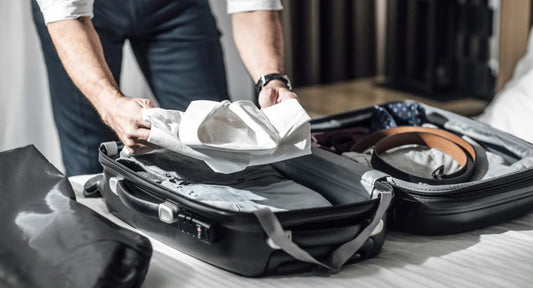How to Choose Classic Men’s Suits for Job Interviews
Share
The Suit That Seals the Deal
You have mere seconds to make a lasting impression in a job interview. While your skills and experience are paramount, your appearance plays a significant role in shaping that crucial first impression. Finding the best men's suits and understanding what makes suits a classic is crucial for interview success. The right suit not only projects professionalism but also boosts your confidence, setting the stage for a successful interview.

Understanding the Importance of Classic Men's Suits
A classic men's suit is defined by its timeless elegance, clean lines, and understated sophistication. It's the sartorial equivalent of a firm handshake—a symbol of respect and professionalism that transcends fleeting trends. These suits are typically crafted from high-quality materials, feature traditional cuts, and offer a versatile foundation for building a polished look.

First impressions matter, and a classic suit signals to your potential employer that you take the opportunity seriously. It conveys a sense of preparedness, attention to detail, and respect for the company culture. Moreover, donning a well-tailored suit can boost your confidence, helping you project an air of self-assurance that can tip the scales in your favor.
Choosing the Right Color
When selecting a suit for an interview, color choice is paramount. Stick to safe, universally accepted colors such as Navy, charcoal, or classic medium gray. These hues project professionalism, confidence, and trustworthiness.
However, it's worth considering the specific industry you're interviewing for. If you're aiming for a position in finance or law, it's best to stick to the more conservative end of the spectrum. In contrast, a creative field might allow for a slightly lighter shade or a subtle pattern.
Color psychology plays a subtle yet significant role in perception. The Navy exudes authority and trustworthiness, while gray suggests sophistication and neutrality. Choose a color that aligns with the image you want to portray and complements your skin tone.
Selecting the Perfect Fit
A suit's fit can make or break your appearance. An ill-fitting suit can appear sloppy and unprofessional, while a well-tailored suit enhances your physique and projects confidence. Ensure the shoulders sit squarely, the waist is gently tapered, and the trousers and sleeves are the appropriate length.

While custom-tailored suits offer the ultimate fit and personalization, they can be a significant investment. Off-the-rack suits can be a budget-friendly option, but it's essential to prioritize fit and invest in alterations if needed. A few minor adjustments can make a world of difference.
Consider your body type when selecting a suit. Slimmer cuts can flatter athletic builds, while a more classic fit might be ideal for broader frames. Remember, the goal is to feel comfortable and confident in your attire.
Style and Cut
Suit styles and cuts evolve, but certain elements remain timeless. A single-breasted suit with two buttons is a safe and versatile choice for job interviews. Double-breasted suits, while stylish, can be perceived as more assertive and might not be suitable for all industries or body types.
Modern slim-fit suits offer a contemporary silhouette, while traditional cuts provide a more classic and conservative look. The choice between them depends on your style, the company culture, and the specific role you're applying for.

Accessories play a supporting role in completing your look. Choose a tie that complements your suit color and features a subtle pattern or texture. A simple leather belt and polished dress shoes in black or brown are essential finishing touches.
Dressing for Success
A well-chosen suit is just the foundation. Grooming is equally essential. Ensure your hair is neatly styled, your facial hair is well-maintained, and your nails are clean and trimmed.

Select a crisp, ironed dress shirt in white or light blue. Avoid loud patterns or bright colors that can be distracting. Pay attention to the fit of your shirt as well—it shouldn't be too tight or too loose.
Finally, pay attention to the importance of polished shoes. Invest in good leather dress shoes and keep them clean and well-maintained. Scuffed or worn-out shoes can detract from an otherwise polished appearance.
Pre-Interview Checklist:
- The suit is clean and pressed
- The shirt is ironed and wrinkle-free
- Shoes are polished
- The tie is neatly tied
- Hair is styled and groomed
- Nails are clean and trimmed
Conclusion
Choosing the right suit for a job interview is an investment in your professional future. An impeccably tailored and styled classic suit conveys confidence, competence, and respect. The subtle edge can set you apart from other candidates and help you land your dream job.
Remember, the best men's suits aren't just about looking good but about feeling good. When you feel confident in your attire, that confidence radiates outward, leaving a lasting impression on your potential employer.
Ready to step into your next interview with confidence and style? Explore Suitharbor's collection of the best men's suits, tailored to perfection and designed to empower you on your career journey.


